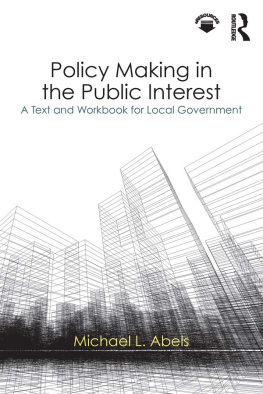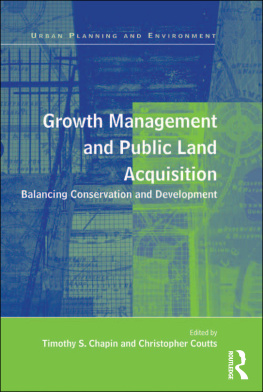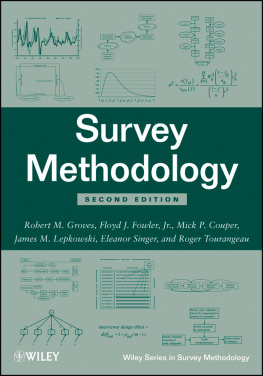Originally published in the United States of America by the Center for Urban Policy Research
Published 1978 by Transaction Publishers
Published 2017 by Routledge
2 Park Square, Milton Park, Abingdon, Oxon OX14 4RN
711 Third Avenue, New York, NY 10017, USA
Routledge is an imprint of the Taylor & Francis Group, an informa business
Copyright, 1978, RutgersThe State University of New Jersey.
All rights reserved. No part of this book may be reprinted or reproduced or utilised in any form or by any electronic, mechanical, or other means, now known or hereafter invented, including photocopying and recording, or in any information storage or retrieval system, without permission in writing from the publishers.
Notice:
Product or corporate names may be trademarks or registered trademarks, and are used only for identification and explanation without intent to infringe.
Library of Congress Catalog Number: 77-24034
Library of Congress Cataloging in Publication Data
Burrows, Lawrence B
Growth management.
Bibliography: p.
1. Cities and townsUnited StatesGrowthManagement. 2. SuburbsUnited States. 3. City planningUnited States. 4. ZoningUnited States. I. Title.
HT123.B85 309.260973
ISBN 0-88285-043-1
77-24034
ISBN 13: 978-0-88285-043-6 (pbk)
Contents
Preface
There are specific topics which, in microcosm, bring together many of the strands of a whole society. The pressures at work in responding to the problems involved in these topics both in implementing and retarding their resolution, provide a unique insight into the strains of our time. In many ways, the subject of growth controls is a prime exemplar of this species. Grouped under this rhubric are all the environmental concerns which are increasingly prominent: the natural limits of land-holding capacity, the trade-offs between intensive land use, and the physical limitations of earth and space.
But these elements, while far from easily defined, are much more finite than the particulars at the other end of the spectrum that of the character and individual substance and way of life, which revolve around the level of intensity of land use. For example, as we near the end of the twentieth century, an increasing demand is heard for a return to a simpler, more bucolic environment. Just as the suburb replaced the city as the prime locational target so the suburb in turn finds it very difficult to compete against the lures of the countryside. The drive toward exurbia, and with it greater levels of decentralization-if not socialatomizationbecomes a dominent theme, at least for the affluent.
Lodged precariously between these poles are innumerable other parameters that must be reconciled. To name just a few is to slight the vigor of the many, but given that risk, let me mention at the very least the aspirations for lebensraum of minority groups seeking their place in the suburban sun; of the new home aspirant who finds that land costs make the most potent of rewards in our society, the private home, a more and more difficult target; of people who have bought land under the presumption that they can build on it in a fashion which will maximize its value only to have value dissipated by local authorities desperate to minimize development; of the older home occupant dismayed by the taxes reflective of growth and no growth.
All these and many other elements are at work within the simple title of Growth Control. How are these elements to be reconciled and yet provide a modicum of equity for the several players both within current times and the future? It is this very important question to which this work is addressed. In it, Larry Burrows, our former student and colleague, provides the crucial tools and methods of planning, of allocation technique, and the like. The resolution of the long-range philosophical and political questions must remain for later workerswithin a society less irresolute than our own.
GEORGE STERNLIEB
Center for Urban Policy Research
Acknowledgments
I am especially appreciate of the support of the Center for Urban Policy Research for this research effort, which has spanned my graduate work at the University of Pennsylvania to my present responsibilities with Gladstone Associates. In this regard, I wish to thank Dr. James W. Hughes for initially envisioning the project, Dr. Robert W. Burchell for continually backing my effortsespecially at critical junctures, Stepen R. Seidel for thoughtfully critiquing initial drafts, and Dr. George Sternlieb for his encouragment to publish the study. Their collective impact immeasurably strengthens the book.
Other people have given freely of their time. While at the University of Pennsylvania, I received enlightened guidance and encouragement from Professor Ann Strong. Her ideas regarding the books structure and content added an important element of cohesion. Similarly, the genius of Professor Jan Krasnowiecki is manifest throughout, challenging conventional wisdom and improving our understanding of land use controls. As lawyers and planners they have demonstrated a unique ability not to be intimidated or confined by the law, but rather to use it to shape more responsive planning programs.
Since leaving the university, my colleagues at Gladstone Associates have been particularly generous in affording me the time to finish this analysis and in enabling me to draw upon their extensive land development experience.
As with any comparable undertaking, the typing demands were enormous. The Centers typing staffJoan Frantz, Anne Hummel, and Lydia Lombardi typed initial and revised drafts. I am especially grateful to Diana Dempsey for her patience and long hours in readying the final version. I would like to thank Kathleen Agena and Joseph P. Zimmerman for editing the manuscript, Margaret P. Roeske for her fine proofreading, and Barry O. Jones, the Centers Director of Publications, for guiding the book through to publication.
All these people are responsible for improving the content of the book; any errors, omissions, and misinterpretations remain my own.
L.B.B.
Chapter One:
Introduction
T he legacy of Daniel Burnham endures through his oft-quoted credo, Make no little plans; they have no magic to stir mens blood. However, given the complexity of urban and environmental problems facing planners today, Burnhams motto, reinterpreted for today, might well be make no little plans; in fact, dont make any plans at all.
As the country moves further into the post-industrial era, the philosophical and technological underpinnings that fostered this transition are being reevaluated. Limitless energy, abundant open space, and an unsaturated environment are no longer being perceived as infinite quantities. For years economic and physical expansion was considered analogous with increasing opportunity, heightened social mobility, and rising affluence. Today, it is inconceivable that these pursuits can be continued without first assessing their impacts. These latent trends are becoming more visible, questioning relatively unconstrained expansion, challenging the sacrosanct American growth ethic. While there has always been periodic antigrowth sentiment, its current appeal and permeation in all levels of society indicate a profound change in attitude. As William Reilly aptly put it:









